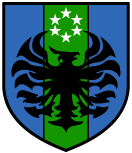Difference between revisions of "Wingarde"
m (→National Government) |
|||
| Line 143: | Line 143: | ||
=== National Government === | === National Government === | ||
| − | The Wingardian Constitution, completed in 1947, establishes a democratic, federal and representative government, and mandates a separation of powers between executive, legistlative and judicial branches at the national and state levels. Both the president and vice-president are elected for office every six years. They are not allowed two consecutive terms, but it's possible for them to be elected for a third term or more after the interval of at least one term. | + | The Wingardian Constitution, completed in 1947, establishes a democratic, federal and representative government, and mandates a separation of powers between executive, legistlative and judicial branches at the national and state levels. Both the president and vice-president are elected for office every six years. They are not allowed more than two consecutive terms, but it's possible for them to be elected for a third term or more after the interval of at least one term. |
The legislature of Wingarde is the unicameral Federal Congress, which contains 36 seats, distributed equally among the senators of each Wingardian state. Senators serve 4-year terms. | The legislature of Wingarde is the unicameral Federal Congress, which contains 36 seats, distributed equally among the senators of each Wingardian state. Senators serve 4-year terms. | ||
Revision as of 15:47, 4 January 2007
| |||||
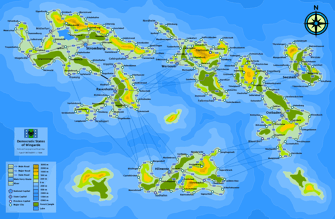 Enlarge | |||||
| Motto - English |
"Acta non verba." "Actions not words." | ||||
| Official Languages | German, English | ||||
| Capital | Stromburg | ||||
| President | Hermann Jakob | ||||
| Area - Total - Water |
1,317,583 km² 16,024 km² (1.23%) | ||||
| Population - Total (Dec. 2006) |
>2.8 billion | ||||
| Independence - Declared - Recognized |
From Great Britain December 11, 1946 August 6, 1948 | ||||
| Constitution - Completed - Ratified - Effective |
February 7, 1947 April 29, 1947 July 15, 1947 | ||||
| Government Type | Representative Democracy | ||||
| Nation Type | Federal Republic | ||||
| National Animal | Hawk | ||||
| GDP (Dec. 2006) - Total - GDP/capita |
117 trillion talons Ŧ40,984 | ||||
| Currency - Code |
Talon ( Ŧ ) WGTL | ||||
| Time Zone | GMT +10 | ||||
| International Abbreviation - Sports |
WAWG WNG | ||||
| Naval Craft Classification | WFN (Wingarde Federal Navy) WCS (Civilian) | ||||
| Internet TLD | .wg | ||||
| Calling Code | +73 | ||||
| Stats: NSEconomy Pipian XML | |||||
Wingarde (or The Democratic States of Wingarde, German: Wingarde or Demokratischen Staaten von Wingarde) is a large, economically powerful country located on the North Pacific.
Wingarde is a democratic federal representative nation with a division of powers between executive, legislative and judicial branches. It's made up of six states, which represent the six inhabited islands of Wingarde Archipelago. The other three isles are currently unoccupied, and are protected as natural monuments.
As of now, Wingarde is not a member of any international alliance or pact.
Contents
History
Early History (~1000 BC - 1879)
Archaelogical research on the islands suggests that a primitive, chieftain-based society settled Wingarde Archipelago over 3,000 years ago. The early natives excelled in agricultural and fishing activities. The tribes gradually developed a religious system, which primarily worshipped the sun and the hawk as its messenger, and maintained a stable economy. They prospered peacefully and isolated from the rest of the world for over 2,500 years.
Diverse European explorers discovered the archipelago around the 16th century. The Spanish eventually claimed sovereignty over the islands, but disregarded settling it given the fact that natives showed hostility against foreigners, and Spain currently couldn't afford taking them by force.
A major revolution took place not long after the encounter with the Europeans, apparently for religious purposes. The religion, and society with it, crumbled because one of its main pillars was that there was supposedly nothing beyond the islands. The arrival of foreigners inevitably destroyed that belief. The prosperous native empire shattered and every settlement became independent, reluctant to trust each other.
German Period (1879 - 1914)
Around the middle of their colonial expansion, the Germans arrived at the archipelago in 1879. The explorers found the weak natives to be not much of a threat. Even though they offered resistance, their wooden spears were no match for modern rifles. The descendants of the ancient native empire were quickly defeated, the scarce survivors integrated to the islands' new population, which settled them in 1881. The lands were deemed Wingarde by their new inhabitants.
The Germans thoroughly developed the islands, harvesting the land, exploiting its resources and building most of Wingarde's current major cities. Stromburg, the current capital, was the first settlement built by the pilgrims. Governed by the German Empire, the archipelago successfully prospered until World War I broke out in Europe.
British Period (1914 - 1946)
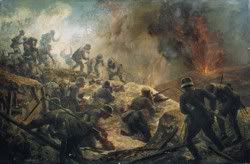 The German garrison heroically defended the archipelago, but was eventually overrun by the British invaders |
|---|
In 1914, all of the German colonies in the Pacific were taken by Germany's enemies. British forces seized control of Wingarde Archipelago after defeating the puny garrison defending it, and claimed sovereignty over the islands in the name of the King, George V.
The now British colony kept thriving despite having lost its first fatherland. A strong, intensive program to establish English as the archipelago's main language was carried out. The teaching of English was made compulsory in schools. The new government also attempted to remove German as a subject from the educational institutions, but this measure faced severe opposition by part of the population, and was ultimately abandoned to avoid civil unrest. Despite the educational measures, German remained the main language of the islands, with English as the secondary one.
The British government further industrialized the Wingardian territories, introducing extensive railroads, building large ports and improving the mines established to exploit the recently-discovered iron deposits in the mountains of the island of Wernover.
During World War II, Wingarde proved to be a strategic point in the Pacific. The Japanese repeatedly tried to take over the islands, but were repelled by their stout defenders and elements of the Royal Navy in every single attempt made. Japan eventually refrained from launching further assaults on the archipelago as the war went on and the balance tilted in favour of the Allies, and concentrated its military efforts on fighting the Americans, who were advancing dangerously into Japanese territory.
Independence and Constitution (1946 - 1947)
Secret talks about independence had been taking place since the early 1940s among some of Wingarde's officials, but with the coming of WWII to the Pacific, the idea was put on indefinite hold. Should've the archipelago declared independence in the middle of the war, the Japanese would've easily taken control of the islands, which would've not been able to defend themselves without British aid. Instead, the government decided to wait for a better opportunity.
The next opportunity presented itself by the end of 1946. The war was over, but the United Kingdom's strength and economy was left deteriorated, the latter facing a potential crisis. Taking advantage of the situation, the government of Wingarde declared the independence of the whole archipelago on December 11th, 1946. The British administration was shocked when the news came, but the current state of the country wouldn't allow any kind of military retaliation. Great Britain sent several diplomatic proposals to avoid losing its colony, but it was eventually forced to acknowledged Wingarde as a full-fledged independent state, and gave up all sovereignty over the islands to the Wingardian government.
The Democratic States of Wingarde adopted a democratic, federal and representative form of centralized government, dividing powers in the executive, legislative and judicial branches. The nation's constitution was completed on February 5th, 1947, and became effective in less than six months (July 15th).
Development in Isolation (1947 - 1995)
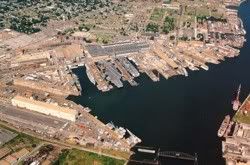 Several dry docks owned by Ravenholm Shipyards |
|---|
As an independent nation, Wingarde progressed notably better than some of the other countries in the Pacific. Raynard Stammler, the first constitutional president, elected in 1947, ensured the economic stability of the archipelago. However, during his administration, several laws that favoured isolation and protectionism were passed. These resolutions were enacted to encourage independent economic development and prevent imperialism from foreign powers, especially the former allies from WWII, and mainly the United States, which had claimed sovereignty over many territories it took from Japan during the war. Nevertheless, the isolation ultimately harmed Wingarde as international relations became severely limited for the country's needs.
The nation just could not supply itself with everything necessary, so eventually general imports, mainly military and industrial equipment, were allowed during the first presidency of Gilbert Reifsneider. The economic power began growing again as national industries were founded all over the archipelago. Today's most important part of the private sector, the automobile manufacturing industry, appeared in the 1970s.
Imports involving industrial and military equipment eventually became a liability, unnecessarily straining the national economy, so an innovative plan was implemented during the two Schlosser administrations. Products manufactured by national industries would not only completely replace imports, but would also be exported all over the world within the next 25 years. The new economic policy began with the founding of Ravenholm Shipyards in 1985. The Schlosser Plan, as it was later deemed, would be the first step towards the integration of Wingarde to the global scene.
International Integration (1995 - Present)
The Schlosser Plan was continued during the Breuer administration, which spanned from 1995 to 2001. It further developed diplomatic relations with several countries, and enhanced the national industry. The main representation of that was the creation of Wingarde Aerospace in 1995. This outstanding achievement improved the economy by replacing the imported aircraft by ones, according to some people much better, made on Wingardian soil. The Ministry of Defense was even more pleased than it was ten years earlier, with Ravenholm Shipyards. Both corporations prospered, but the newer one eventually surpassed the older one, mainly because there was a higher demand of aircraft in the country and in the international scene.
The current president of Wingarde, Hermann Jakob, elected in 2001, has continued the integration of the nation in global affairs. Seeing that the country was rapidly becoming both economically and strategically important to other, larger powers, in 2002 he enacted a policy that allowed for military build-up. The defense budget grew considerably, until the Ministry of Defense agreed on a suitable spending. Despite his interest in further increasing the Wingardian activity in foreign affairs, social welfare is still an important part in Jakob's agenda.
The future of Wingarde is uncertain. Alliances with foreign powers and increased participation in the global affairs will certainly earn the nation a few enemies in the coming decades. Hopefully, Wingarde will be strong enough and have enough allies to counter any major threats to the security of its citizens.
National Emblems
Flag
The main national emblem, the hawk on the center of the flag, symbolizes the light and Heavens, below whom the nation was founded, and the power and watchfullness of the Wingardian people. The central green pale describes the evergreen plains and forests of the nation's islands. The blue pales stand for the sapphire waters of Wingarde, the rivers and the sea that surrounds the nine islands. Finally, the six stars represent the six island-states of Wingarde.
Animal
The hawk is Wingarde's national animal. Standing for the light and the Heavens, it represents the people's firm belief in God Almighty. It symbolizes visionary power and guardianship, as the hawk is very protective of the young in its nest. It represents providing for family and self. The bird inspires Wingardians to be observant and to pay attention to details that might be overlooked. The hawk has keen eyesight, and indicates the inquisitiveness of the people of Wingarde, who tend to see beyond first appearances.
Politics
National Government
The Wingardian Constitution, completed in 1947, establishes a democratic, federal and representative government, and mandates a separation of powers between executive, legistlative and judicial branches at the national and state levels. Both the president and vice-president are elected for office every six years. They are not allowed more than two consecutive terms, but it's possible for them to be elected for a third term or more after the interval of at least one term.
The legislature of Wingarde is the unicameral Federal Congress, which contains 36 seats, distributed equally among the senators of each Wingardian state. Senators serve 4-year terms.
Head of State
Current Head of State: Hermann Jakob (elected in 2001)
Previous presidents:
- 1995: Friedrich Breuer
- 1989: Bernhard Schlosser (second term)
- 1983: Bernhard Schlosser
- 1977: Sebastian Nerburn
- 1971: Manfred Adler
- 1965: Gilbert Reifsneider (second term)
- 1959: Gilbert Reifsneider
- 1953: Charles Calton
- 1947: Raynard Stammler
Before the constitution was finished in February, 1947, the newborn nation was ruled by what was later called the Triumvirate of the Generals, given the fact it was a temporary shared government between Wingarde's first three generals, formerly loyal to the British Crown: Alphonse Hoffmann, Edward Stanley and Thomas Dennett. The triumvirate was dissolved once the constitution became effective, and the commanders returned to the armed forces and continued their careers there.
Foreign Relations
Wingarde's presence in international affairs had been notably low for most of its existence as an independent nation. However, ever since the first months of the presidency of Friedrich Breuer, the country has become increasingly active in world affairs. The Breuer administration ensured the integration of Wingarde to the global scene by passing several laws and intensifying the exports of Wingardian goods, especially automotive industry products, such as the military aircraft produced by Wingarde Aerospace, the warships manufactured by Ravenholm Shipyards and the vehicles built by Falken Armour Works.
Even though the nation maintains a steady state of neutrality towards most of the world's countries, states such as Karmanyaka, Listeneisse, Triancia and Van Luxemburg are considered allies. As Wingarde grows in economic, social and military power, alliances but also tensions will likely appear.
Armed Forces
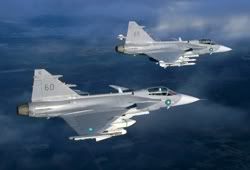 Two Wingarde Federal Air Force WF-27 Firebolts on patrol |
|---|
- Main article(s): Federal Armed Forces of Wingarde
The Wingardian Federal Armed Forces are Wingarde's means of defense against both foreign and internal threats. It is divided into Wingarde Federal Army, Navy, Air Force and Sapphire Guard branches. Military service has always been voluntary, and will not be made compulsory in the foreseeable future. Nevertheless, the Wingardians are very patriotic, and the Armed Forces employ approximately 0.7% of the total population. In peacetime, the institution is commanded by the Minister of Defense. However, in wartime, the President of Wingarde becomes the commander in chief of the national military.
As of now, the defense budget is a secondary priority in the goverment (approximately 11% of the budget). Nevertheless, the Ministry of Defense has deemed the military spending adequate for Wingarde's current situation. It is enough to allow national military industries such as Wingarde Aerospace, Ravenholm Shipyards and Falken Armour Works to properly supply the Armed Forces and even export products to foreign powers, providing economic profits for the islands.
Ever since Wingarde's increase in international participation, military interventions on foreign countries have become increasingly common, though these are always carried out with the intervened nation's government's consent. As of now, Wingarde has never taken part in any major armed conflict, only small operations.
Recent military operations
Hijacking of the VLS Koen
The VLS Koen, a Van Luxemburgian luxury liner, was seized by terrorists in the vicinity of Guyana Island. The government of Van Luxemburg immediately dispatched counter-terrorist units and asked for international aid in order to carry out a joint operation to eliminate the terrorist threat. Wingarde, along with Kjata Major and McKagan among others, quickly responded and sent two Special Combat Forces teams, led by Major Frederik Brentsen to deal with the hijackers. The operation itself, which commenced around midnight, took less than 12 hours. All the terrorists either surrendered or were killed by the allied forces, except from their leader, who escaped. The hostages suffered minimal losses and the ship itself was only lightly damaged, mainly due to heavy gunfire and occasional attacks by allied helicopters. The Wingardian operatives suffered a total of four casualties: two wounded and two killed. (In RL time, this operation extended from August 20th to 24th, 2005).
Guyana Island conflict
Soon after Van Luxemburg granted independence to its former colony, Guyana Island, tensions erupted between the new nation and its former fatherland. After a series of incidents of dubious nature between both countries' military elements, the crisis escalated to outright war. The Guyanans invaded Ostrhain, the closest Van Luxemburgian province in Kreuzbadinsel, with approximately 200,000 troops. The defenders found themselves greatly overwhelmed and were forced to retreat to Westrhain and regroup. In the meantime, Van Luxemburg was preparing a sizeable force to retake the invaded territory from the west coast of their side of Kreuzbadinsel.
President Jakob, seeing Guyana as a threat to the citizens in the Wingardian-controlled South Kreuzbadinsel, issued an ultimatum to the self-proclaimed ruler of Guyanan Island, Thierry Karbel, demanding the cease of hostilities and return of rightfully Van Luxemburgian territory. Triancia followed with an ultimatum of its own. The Guyanan dictator mocked the threats of the two nations and declared war on them too.
Fortunately the current South Kreuzbadinsel garrison was enough to deal with the enemy invasion force. The 4th Infantry and 9th Armoured divisions were mobilized from Melcheldorf and Küstenfläche to the Westrhain-Ostrhain border, while Federal Navy elements from Task Force Garm were deployed to the Guyana Strait.
Air superiority had been achieved by Van Luxemburg long before Wingarde entered the conflict, but the Navy and Army played a crucial role. Task Force Garm, along with Triancian and Van Luxemburgian naval groups, managed to blockade Ostrhain and cut the enemy supply lines supporting the invaders. The impact of this measure on the enemy was specially devastating, since it allowed Wingardian army units and Triancian marine contingents to wipe out the Guyanans still willing to fight with badly supplied equipment.
Once the main Guyanan force was defeated, the allied forces retook control of Ostrhain and staged a landing on enemy coasts. By this time the opposition's morale was considerably low, and few soldiers thought it was worth to keep fighting. Most of them surrendered, while the scarce remaining loyalists retreated to the jungles, from where they still show some degree of resistance against the occupation troops. Thierry Karbel is thought to have fled Cayenne, Guyana Island's capital, as soon as he received notice of the landing of his enemies on his own soil.
The victorious Wingardian divisions received mixed feelings among the populace when they entered Cayenne. A part of the inhabitants was pleased to have their unpopular dictator taken out of office, whereas others reacted poorly at being under foreign control again. However, the most common feeling among Cayenne's citizens was indifference.
Elections have been scheduled to take place soon. The Guyanans will be given the opportunity to choose their own leader through democracy, and will have their independence restored once a stable, sovereign government is formed and consolidated. (In RL time, this conflict extended from February 26th to March 17th, 2006)
Geography
States
Wingarde is divided into six states, which represent each of the populated islands of the archipelago: Stromburg, Ravenholm, Wernover, Ostbaden, Seestadt and Hilmentz. It is further subdivided into nineteen districts within the states. Each state capital bears the same name as their corresponding territory.
Territory
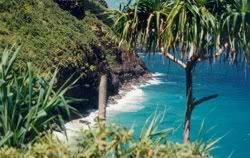 The seaside cliffs on the island of Ostbaden |
|---|
The Wingarde Archipelago is located in the North Pacific, 221 kilometres south of the Tropic of Cancer and 2,173 km north of the equator. It consists of nine islands covered in grasslands, dense rainforests and frequent land elevations, most of the highest ones being inactive volcanos. There's a single river in Wingarde, the Krause, which courses oddly around the mountains of Wernover and ends in the island's eastern coast. Six of the archipelago's islands are currently inhabitated: Stromburg, Ravenholm, Wernover, Ostbaden, Seestadt and Hilmentz. The remaining three, Gersten, Smaragdwächter and Pfeilspitze are unoccupied, deemed natural reserves. The islands' highest point is Mount Himmel, on the smallest land mass of the archipelago, Smaragdwächter. Gersten, 70 km off the coast of Hilmentz, is the largest uninhabited island.
Wingarde's territory is contained in approximately 1,317,583 km2, and has five neighbours: Marcus Island (280 km north of Stromburg), the Federated States of Micronesia (the Hall islands are 1,198 km south of Gersten), the Marshall Islands (the island of Enewetak is 696 km south of Pfeilspitze), Wake Island (477 km east of Seestadt) and the Northern Mariana Islands (the islands of Anatahan are 1,326 km west of Gersten).
Climate
The archipelago has a tropical marine climate moderated by seasonal northeast trade winds. There is little seasonal temperature variation; the dry season runs from December to June, the rainy season from July to October can include typhoons. The islands' large amount of rainforests contribute to the general moist and warm temperatures (over 18 °C, 64.4 °F, in all twelve months of the year). The climate of the northernmost parts of Wingarde generally resemble more of a subtropical one.
Society
Demographics
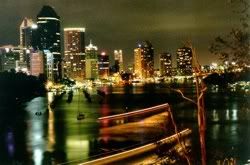 The Wingardian capital, Stromburg, at night |
|---|
Wingarde's people are mostly concentrated in the urban areas, and only the 13% of the inhabitants live in the small towns of the country. Urbanization is gradually consuming the country as the population grows.
The largest cities are obviously the state capitals, considerably surpassing most of the other towns. Stromburg, the Wingardian capital, is the biggest urban conurbation, providing living space for 1.8% of the nation's inhabitants. The city of Ravenholm is not far behind, with 1.5% of the people dwelling there. Ostbaden is the third largest town in Wingarde, where 1.1% of the citizens have their homes in. The rest of the large to medium urban centers are Wernover, Hilmentz, Seestadt, Framzig, Nordheim and Falkenschau, among others.
Regarding cultural diversity, the majority of the citizens are descendants from Germans, and even though the British had a strong presence in the archipelago in the first half of the 20th century, only a mere 21% of the inhabitants are from British descent. Due to the partial isolation of the country in the past, Wingarde rarely accepted immigration from other nations during most of its history, unless it were an emergency. However, the recent policies enacted in the last few years are slowly changing this fact. Foreign refugees have turned their heads towards Wingarde in the past, and were harboured in the country, provided they would work in exchange for a subsistence salary.
Religion
Religious beliefs are fairly common in Wingarde. Church and state are separate, but work together in several fields, mainly the social sector. Christianity, especially Roman Catholicism, is the leading religion in the nation: 76% of the population is Catholic and 17% is Protestant. Followers of other religions, such as Jews (3%) and Muslims (1%), comprise the remaining inhabitants with religious identity in the archipelago. Lastly, the other 3% of the citizens are either non-religious (including atheists and agnostics) or belong to free churches or minor groups.
Education
Wingarde offers its citizens one of the world's highest levels of education. A sizeable portion of the government's budget goes to Education, allowing the proper maintenance of the corresponding institutions, providing the latest equipment (books, computers, furniture, etc.) in order to enhance the learning process, and getting highly regarded professionals to teach in educational organizations.
English, being the second official language, it taught in every school along with German. The most important foreign languages taught at them are mainly French and Spanish. The principle that education is the base to promote international understanding is the paradigm of Wingardian educational institutions.
Given the fact that schools develop not only the knowledge but also the social skills of their students, home schooling has been deemed illegal. The government strongly enforces this stance, which is unlikely to change despite facing some opposition.

